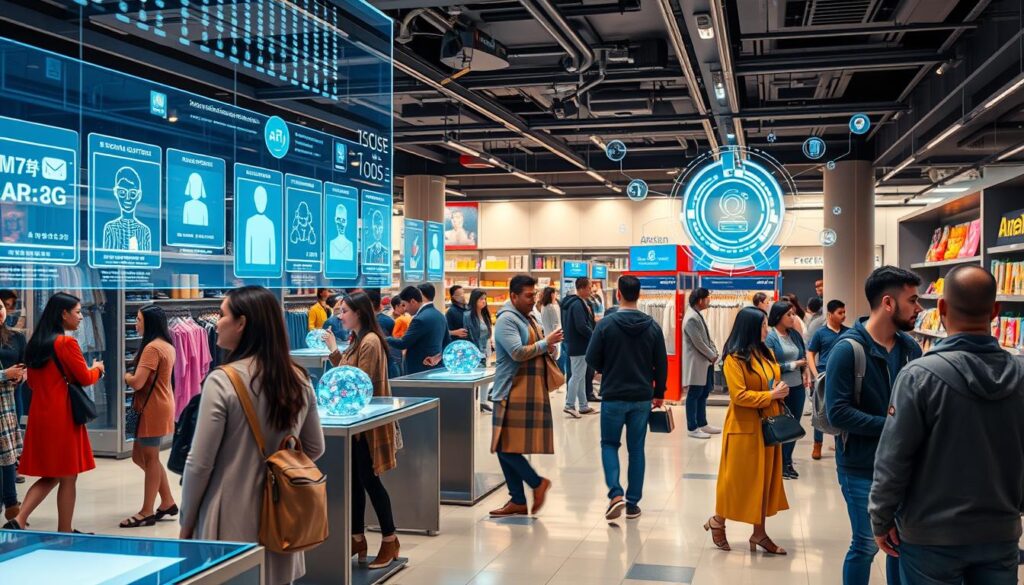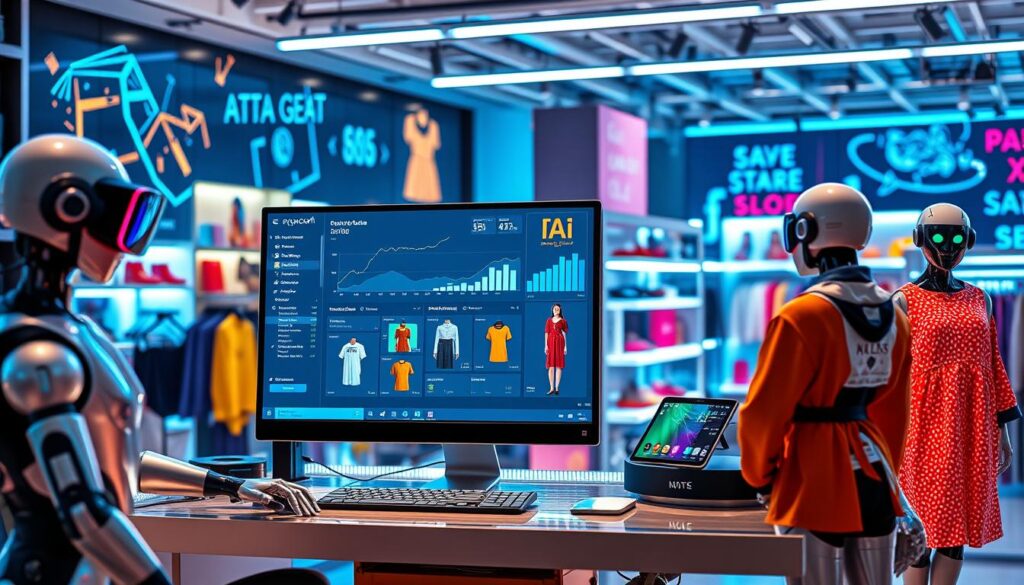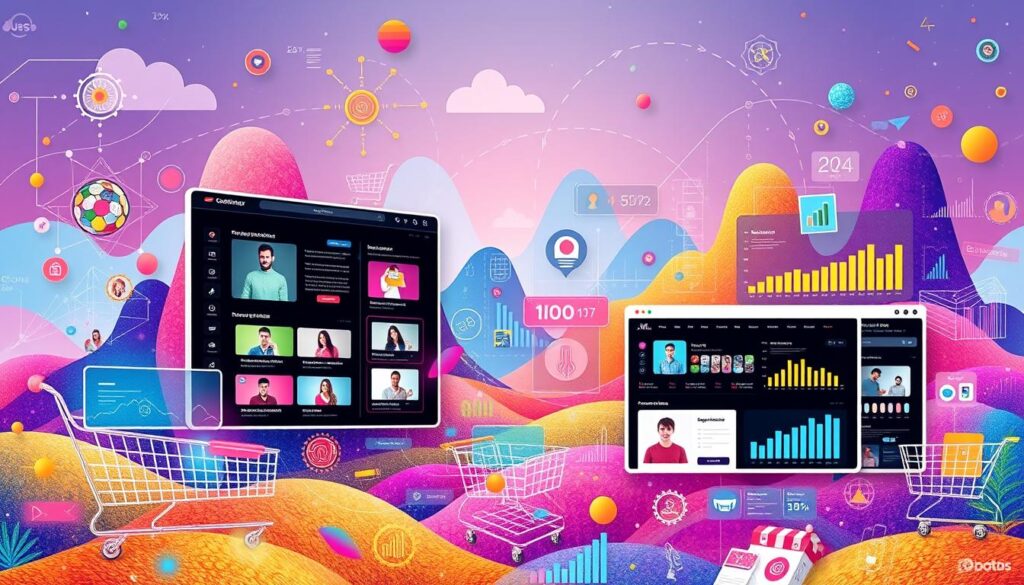Did you know 69% of shoppers want to see new items every time they shop? This shows how hard it is for online stores to keep customers interested. Using AI in e-commerce is key to making shopping better. It lets companies make experiences unique and automate tasks.
AI makes shopping more fun and valuable. Tools like AI chatbots and smart recommendations help businesses serve customers better. In fact, 57% of marketers think customer experience AI is vital for personal interactions1. These tools not only make customers happier but also keep them coming back, which boosts sales.
Companies that use AI strategies are ahead of the game. Personalization is not just about being different; it’s about surviving in a tough market. For more on how to improve customer experiences, see this resource.
Key Takeaways
- 69% of shoppers demand new merchandise regularly.
- 57% of marketers view AI personalization as essential for customer interactions.
- AI tools enhance shopper engagement and personalize experiences effectively.
- Real-time data can revolutionize how businesses interact with customers.
- Implementing AI can drastically improve conversion and retention rates.
Understanding AI in E-commerce
Artificial Intelligence (AI) is changing e-commerce, making online shopping better. It uses natural language processing and conversational AI to understand big data. This helps make shopping more personal for everyone2.
What is AI?
AI means making computers do things that humans do. It uses machine learning, natural language processing, and data analytics. For example, AI helps e-commerce sites suggest products based on what you like. This can boost sales by up to 35% for companies like Amazon3.
AI technologies also improve marketing by understanding what customers want. This makes shopping more enjoyable for everyone.
The Role of AI in Online Retail
In online shopping, AI makes things easier from setting prices to helping customers. AI chatbots offer 24/7 support, making customers happier and more loyal3. These chatbots use conversational AI to help find products and answer questions quickly.
Big e-commerce sites also use AI for better logistics. This makes supply chains more efficient and sustainable4.
The Importance of Customer Experience
In e-commerce, a great customer experience is key to keeping customers coming back and boosting sales. A good experience can make people want to buy from you again. Studies show that 65% of those who focus on customer experience see AI as crucial for better interactions5.
This is because personalized shopping is a big deal for customers. It shapes how they see your brand.
Why Customer Experience Matters
Today’s shoppers want fast, personalized service. In fact, 68% like AI chatbots for their quick answers5. These chatbots are always there, helping late-night shoppers especially6.
Personalization is essential. Companies like Amazon use advanced algorithms to keep customers happy and loyal6.
Key Factors Influencing Shopping Experiences
Businesses need to keep up with what customers want. AI helps predict needs and tailor services5. Being able to change quickly is key, as two-thirds of shoppers might go elsewhere if they can’t find what they need7.
It’s also important to connect with customers on a personal level. Personal touches in service can make a big difference in loyalty and advocacy6.

Benefits of AI in Personalizing Shopping Experiences
AI in e-commerce offers big advantages for brands and their customers. By using AI, businesses can make shopping more personal. This leads to better customer engagement and loyalty.
Improved Customer Engagement
AI helps businesses connect with customers better. Studies show 69% of customers are more likely to buy from personalized brands8. AI makes shopping more tailored, which means more clicks and time on the site9.
Personalized shopping boosts satisfaction and loyalty. It helps businesses keep customers coming back9.
Enhanced Product Recommendations
AI-driven product recommendations are key to sales growth. They help understand what customers want. This leads to better offers and higher sales9.
92% of companies use AI for personalization to boost sales8. Good recommendations can also reduce cart abandonment. This keeps customers coming back for more9.
Personalization can increase revenue by up to 15%. It’s a game-changer in e-commerce, meeting customer needs8.
Data Collection and Analysis
In the world of AI-driven personalization, getting the right data is key. You need to collect different types of data to understand what customers like and how they behave. This info is vital for making marketing campaigns that really speak to shoppers.
Types of Data Used in Personalization
Knowing what data is important for personalization can really help your online store. Here are some key types:
- Customer Purchase History: Looking at what customers have bought before helps guess what they might buy next.
- Browsing Habits: Seeing how customers move around your site shows what they’re interested in.
- Social Media Interactions: Data from social media can help shape your marketing plans.
- Demographic Information: Knowing things like age, location, and interests helps tailor content.
Research shows 60% of people are okay with sharing data for a more personal online experience. This shows a big chance for businesses to use personal strategies10.
Tools for Analyzing Customer Data
There are many tools and ways to dig into the data you collect. This lets businesses use the insights they find. Some top tools include:
- Sentiment Analysis Software: This tech reads customer feedback and reviews to spot trends in feelings.
- Predictive Analytics Platforms: These tools use past data to guess what customers might do next.
- Customer Relationship Management (CRM) Systems: CRMs bring together customer data for better interaction management.
- AI-Driven Marketing Tools: Tools like HubSpot help segment and create personalized marketing campaigns.
AI and machine learning are getting better at spotting trends and predicting what will happen. This has really boosted how customers interact with brands10. For example, AI helps Amazon make 35% of its sales through product recommendations. This shows how good data analysis can be for online stores11.

Implementing AI: Best Practices
To make AI work well in your e-commerce, follow key steps. First, pick the right AI tools. Then, make sure they fit well with your online store. This makes things easier for your team and customers.
Choosing the Right AI Tools
Finding the right AI tools is key for success. About 93% of retail groups talk about generative AI in meetings12. Look for tools that make shopping better by suggesting products just for you. For example, using personalized shopping can boost sales by up to 15%13.
Think about what you want to achieve and what your customers need. Then, pick tools that match your goals.
Integrating AI into Your E-commerce Platform
After picking the right tools, integrate them into your e-commerce platform. This might mean using AI for better supply chain management, like project44 does12. Machine learning can also help manage your stock better by analyzing sales data.
It’s important to check how well AI tools work. About 66% of customers want companies to know what they want13. Automating tasks like data entry can make things run smoother. Making sure AI is easy to use will make customers and your business happy.

Personalization Strategies with AI
AI technologies can greatly improve customer satisfaction and engagement. Dynamic content recommendations are a key method. They offer a tailored shopping experience based on what each user likes and does.
Dynamic Content Recommendations
Dynamic content makes e-commerce sites change in real-time. It shows what’s most relevant for each visitor. AI-driven recommendations give personalized product suggestions, making shopping better.
This approach has shown great results. 92% of businesses use AI for better growth and revenue14. Also, 75% of leaders say AI is key for success14. Traditional methods failed with a 70% abandonment rate in 2024, showing the need for better personalization14.
Predictive Analytics for Inventory Management
Predictive analytics helps manage inventory by predicting stock needs. It uses data on consumer behavior and trends. This way, companies can make smart decisions, reduce waste, and improve customer happiness.
About 70% of eCommerce leaders think AI will boost personalization15. This leads to lower bounce rates and higher engagement, key for sales15. Machine learning also helps forecast inventory better, ensuring products are available when needed.

| Strategy | Impact on Customer Engagement | Effectiveness |
|---|---|---|
| Dynamic Content | Personalized recommendations increase user satisfaction | 92% businesses see revenue growth |
| Predictive Analytics | Reduces inventory waste | 70% decision makers believe it enhances personalization |
Creating a Seamless Shopping Journey
In today’s fast world, online shopping needs to be smooth for customers. AI helps a lot with this, especially with chatbots and virtual assistants. These tools give quick help, making shopping better and more satisfying. Adding these to your site can make customer interactions better and boost sales.
Chatbots and Virtual Assistants
Chatbots and virtual assistants are key in online shopping. They answer questions and help users find what they need. AI chatbots make customers happier, giving businesses a big advantage. More and more, stores see how valuable these tools are for quick help and less work for people16.
Personalized Email Marketing Strategies
Good email marketing keeps customers coming back and engaged. AI helps make emails that really speak to people. It looks at customer data to send the right messages at the right time. This can really up your email open and buy rates, helping your sales17.
Here’s a quick look at how personalized emails can help:
| Strategy | Impact on Engagement | Impact on Revenue |
|---|---|---|
| Personalized Recommendations | Increases open rates by 29% | Leads to 30% higher conversion rates |
| Segmentation | Boosts engagement rates by 50% | Results in 760% increase in revenue |
| Automated Follow-ups | Enhances retention rates by 30% | Increases sales through recurring purchases |
To make shopping smooth, use chatbots, virtual assistants, and personalized emails. These tools can make your customers happier and help your business grow. The right tech mix is key to meeting customer needs and building strong relationships.
For more tips on making shopping personal, check out this resource171618.
Measuring the Impact of AI on Customer Experience
To really understand how AI changes how customers interact with you, focus on specific KPIs. These metrics help you see if AI is making customer experiences better.
Key Performance Indicators to Monitor
It’s crucial to pick the right customer satisfaction metrics. The main ones are:
- Customer lifetime value (CLV)
- Conversion rates
- Retention rates
- Customer satisfaction scores (CSAT)
- Resolution time
- Net promoter score (NPS)
Studies show AI makes a big difference. For example, sixty percent of shoppers buy again after a personalized shopping experience19. Companies like Yves Rocher saw a huge jump in clicks on recommended items20. These numbers highlight how tracking KPIs shows AI’s success in improving customer interactions.
A/B Testing for Continuous Improvement
A/B testing is a great way to improve your AI strategies. By testing different AI setups and tracking KPIs, you can see what works best. For instance, AI for quick problem solving boosts customer satisfaction19. Regular A/B testing helps you keep up with changing customer needs and preferences.
To wrap up, here’s how performance measurement and A/B testing help improve customer experience:
| Performance Indicator | Purpose | Method of Measurement |
|---|---|---|
| Customer Satisfaction Score (CSAT) | Gauge customer happiness | Surveys and feedback |
| Net Promoter Score (NPS) | Evaluate likelihood to recommend | Customer questionnaires |
| Conversion Rates | Measure purchase success | Sales data analytics |
| Retention Rates | Assess customer loyalty | Customer return metrics |

Overcoming Challenges in Adopting AI
Businesses face many hurdles when they try to use AI. It’s important to know these AI challenges to make good implementation strategies. Problems like data privacy and not having enough resources can stop companies from using AI to its fullest.
Common Obstacles Businesses Face
Cost is a big problem for many companies, with 50% of e-commerce businesses facing this issue21. Data privacy rules also worry 35% of e-commerce firms22. Smaller businesses find it hard to keep up with the need for new infrastructure and skilled workers.
Solutions to Implementation Issues
A good data plan is key to solving these problems. It’s important to have clear goals for AI and make sure they match the company’s overall aims. Building trust with customers and being open about how data is used can help with privacy worries.
Using AI can make things run smoother, like a 20% boost in revenue from dynamic pricing22. Brands that offer personalized products see a big jump in customer loyalty. In fact, 91% of people like to shop where they get special recommendations21.
Future Trends in AI and E-Commerce
The world of e-commerce is changing fast, thanks to new AI technologies. These changes are making how businesses talk to customers better. Knowing about these trends helps you get ready and improve your business.
AI Innovations on the Horizon
AI is going to change e-commerce a lot, especially in customer support and making things personal. By 2025, 80% of customer service will use AI, like chatbots, to make things better23. AI has already made e-commerce 25% better in customer happiness, sales, and saving money24.
Retailers who use AI for personal shopping have seen a 40% jump in sales24. This shows how powerful AI can be for making shopping better for customers.
Preparing Your Business for Changes
To keep up with e-commerce changes, you need to plan ahead. Using AI tools keeps your online store competitive, as AI investment has grown a lot since 201524. Also, using AI for personal shopping will help meet what customers want.
By 2025, almost a quarter (23%) of all sales will be online24. Being ready for these changes will make your customers happier and help your business grow.
Conclusion: Elevating Customer Experiences with AI
As your e-commerce business grows in the digital world, using AI is key to better customer experiences. This journey to personalization can greatly improve satisfaction and sales. By 2024, AI and machine learning will add over $1.6 trillion in value, showing AI’s big role in e-commerce’s future25.
AI helps tailor your business to meet customer needs with precision. It uses real-time data to keep up with trends. AI also makes content more real and engaging2526.
Final Thoughts on Personalization in E-commerce
For better customer experiences, AI is not just a trend but a must for staying ahead. AI tools offer insights for personalized messages on different platforms. Start now to make your business ready for these changes and give customers a better shopping experience2627.
Call to Action: Start Your AI Journey Today
Don’t wait for the future; start using AI now. Use the tips from this article to make your customers happier. AI is a strong tool for creating experiences that connect with your audience2527.
FAQ
What is AI in the context of e-commerce?
How does AI improve customer experience?
What data is necessary for AI-powered personalization?
What are some best practices for implementing AI in e-commerce?
How can businesses measure the impact of AI on customer experience?
What challenges may businesses face when adopting AI technologies?
What future trends in AI should e-commerce businesses be aware of?
Source Links
- Ecommerce Personalization: A Complete Guide – https://www.salesforce.com/commerce/ecommerce-personalization/
- Next-Level Ecommerce: AI’s Secret Weapon For Personalized Experiences – https://www.forbes.com/sites/rhettpower/2024/05/12/next-level-ecommerce-ais-secret-weapon-for-personalized-experiences/
- AI in E-commerce – https://adamfard.com/blog/ai-in-e-commerce
- AI for E-commerce and Customer Experience – https://blog.evolv.ai/ai-for-ecommerce-and-cx
- How AI is transforming customer experience for businesses – https://www.fullstory.com/blog/ai-in-customer-experience/
- AI in Customer Service: Revolutionizing Digital Retail – https://www.apu.apus.edu/area-of-study/business-and-management/resources/ai-in-customer-service/
- Council Post: How E-Commerce Brands Can Use AI To Deliver A More Personalized Shopping Experience – https://www.forbes.com/councils/forbestechcouncil/2023/04/21/how-e-commerce-brands-can-use-ai-to-deliver-a-more-personalized-shopping-experience/
- Personalize Your Customer’s Shopping Experience with AI – SPONSOR CONTENT FROM PAYPAL – https://hbr.org/sponsored/2024/05/personalize-your-customers-shopping-experience-with-ai
- 6 Benefits of AI Personalization for ECommerce – New Target – https://www.newtarget.com/web-insights-blog/ai-personalization-ecommerce/
- AI & Data Analytics: Redefining Customer Personalization – https://www.cmswire.com/customer-experience/how-ai-and-data-analytics-drive-personalization-strategies/
- The Role Of AI And Machine Learning In E-Commerce Personalization – https://www.codilar.com/the-role-of-ai-and-machine-learning-in-e-commerce-personalization/
- AI in E-commerce: Artificial Intelligence Trends Shaping the Future of Retail in 2024 | DigitalOcean – https://www.digitalocean.com/resources/articles/ai-ecommerce
- Leveraging AI For Personalized Shopping Experiences | E-CENS – https://e-cens.com/blog/leveraging-ai-for-personalized-shopping-experiences/
- The ABCs of artificial intelligence personalization – https://www.algolia.com/blog/ai/how-ai-powered-personalization-is-transforming-the-user-and-customer-experience/
- AI-Based Personalization: The Future of eCommerce – https://www.fastsimon.com/ecommerce-wiki/personalization/ai-based-personalization-the-future-of-ecommerce/
- Taxually | How Ecommerce AI is Revolutionizing Online Shopping – https://www.taxually.com/blog/revolutionizing-online-shopping-the-benefits-of-ecommerce-ai
- Harnessing the Power of AI in Personalizing the E-commerce Customer Journey – https://www.42signals.com/blog/harnessing-the-power-of-ai-in-personalizing-the-e-commerce-customer-journey/
- The Rise of AI-Powered Personal Shopping Services – https://www.bloomreach.com/en/blog/ai-powered-personal-shopping-services
- How AI Can Transform Customer Experience: 8 Amazing Ways – https://www.net2phone.com/blog/how-ai-can-improve-customer-experience
- AI Personalization in Customer Experience: Measuring ROI Effectively – https://www.bloomreach.com/en/blog/ai-personalization-in-customer-experience
- BruceClay – Future-Proof Your E-Commerce With AI: Trends and Tools – https://www.bruceclay.com/blog/future-proof-e-commerce-ai-trends-tools/
- How AI is Revolutionizing E-commerce: Personalized Shopping Experiences – https://www.linkedin.com/pulse/how-ai-revolutionizing-e-commerce-personalized-shopping-amit-sharma-pjfbc
- The future of AI in e-commerce: Trends for 2025 – https://www.inbenta.com/articles/the-future-of-ai-in-e-commerce-trends-for-2025/
- AI for Ecommerce: How It’s Transforming the Future – https://www.bloomreach.com/en/blog/why-ai-is-the-future-of-e-commerce
- AI Revolutionizing eCommerce: Elevating Customer Experience – https://www.valuecoders.com/blog/ai-ml/ai-ecommerce-customer-experience/
- Elevating Customer Experience with AI-Powered Personalisation – https://www.linkedin.com/pulse/elevating-customer-experience-ai-powered-paul-caruana-coece
- Role of AI in Elevating Customer Experience in E-Commerce – https://nyweekly.com/tech/role-of-ai-in-elevating-customer-experience-in-e-commerce/



